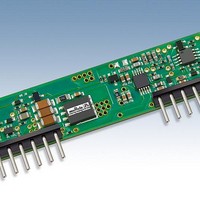LSN-2.5/10-D3BJ-C Murata Power Solutions Inc, LSN-2.5/10-D3BJ-C Datasheet - Page 5

LSN-2.5/10-D3BJ-C
Manufacturer Part Number
LSN-2.5/10-D3BJ-C
Description
DC/DC TH 10A 3-2.5V NS RPV Non-Iso
Manufacturer
Murata Power Solutions Inc
Series
LSNr
Datasheet
1.LSN-1.210-D3-C.pdf
(14 pages)
Specifications of LSN-2.5/10-D3BJ-C
Product
Non-Isolated / POL
Output Power
25 W
Input Voltage Range
3 V to 3.6 V
Input Voltage (nominal)
3.3 V
Number Of Outputs
1
Output Voltage (channel 1)
2.5 V
Output Current (channel 1)
10 A
Package / Case Size
SIP
Output Type
Low Voltage Reversed Pin
Output Voltage
2.5 V
Lead Free Status / Rohs Status
Lead free / RoHS Compliant
For a controlled start-up of one or more LSN-D3's, or if several output volt-
ages need to be powered-up in a given sequence, the On/Off Control pin can
be pulled high (external pull-up resistor, converter disabled) and then driven
low with an external open collector device to enable the converter.
Output Overvoltage Protection
LSN D3 SIP Series DC/DC converters do not incorporate output overvolt-
age protection. In the extremely rare situation in which the device’s feedback
loop is broken, the output voltage may run to excessively high levels (V
V
all possible overvoltage situations, voltage limiting circuitry must be provided
external to the power converter.
Output Overcurrent Detection
Overloading the output of a power converter for an extended period of time
will invariably cause internal component temperatures to exceed their maxi-
mum ratings and eventually lead to component failure. High-current-carrying
components such as inductors, FET's and diodes are at the highest risk. LSN
D3 SIP Series DC/DC converters incorporate an output overcurrent detection
and shutdown function that serves to protect both the power converter and
its load.
If the output current exceeds it maximum rating by typically 60% (16 Amps)
or if the output voltage drops to less than 98% of it original value, the
LSN D3's internal overcurrent-detection circuitry immediately turns off the
converter, which then goes into a "hiccup" mode. While hiccupping, the
converter will continuously attempt to restart itself, go into overcurrent, and
then shut down. Under these conditions, the average output current will be
approximately 400mA, and the average input current will be approximately
70mA. Once the output short is removed, the converter will automatically
restart itself.
Output Voltage Trimming
Allowable trim ranges for each model in the LSN D3 SIP Series are ±10%.
Trimming is accomplished with either a trimpot or a single fi xed resistor. The
trimpot should be connected between +Output and Common with its wiper
connected to the Trim pin as shown in Figure 3 below.
A trimpot can be used to determine the value of a single fi xed resistor
which can then be connected, as shown in Figure 4, between the Trim pin
and +Output to trim down the output voltage, or between the Trim pin and
Common to trim up the output voltage. Fixed resistors should have absolute
TCR’s less than 100ppm/°C to ensure stability.
The equations below can be used as starting points for selecting specifi c trim-
resistor values. Recall, untrimmed devices are guaranteed to be ±1% accurate.
Adjustment beyond the specifi ed ±10% adjustment range is not recommended.
IN
). If it is absolutely imperative that you protect your load against any and
Figure 2a. Inverting On/Off Control Pin Signal and Power-Up Sequencing
0.9kΩ
ON/OFF
CONTROL
COMMON
+INPUT
1.1kΩ
0.75kΩ
5kΩ
Single Output, Non-Isolated, 3.3V
www.murata-ps.com
OUT
=
Output Reverse Conduction
Many DC/DC converters using synchronous rectifi cation suffer from Output
Reverse Conduction. If those devices have a voltage applied across their
output before a voltage is applied to their input (this typically occurs when
another power supply starts before them in a power-sequenced application),
Note: Resistor values are in k:. Accuracy of adjustment is subject to
tolerances of resistors and factory-adjusted, initial output accuracy.
V
O
= desired output voltage. V
Note: Install either a fi xed trim-up resistor or a fi xed trim-down resistor
Figure 4. Trim Connections Using Fixed Resistors
+INPUT
COMMON
LSN-1.2/10-D3, LSN-1.25/10-D3 Trim Equations
Figure 3. Trim Connections Using a Trimpot
LSN-2/10-D3, LSN-2.5/10-D3 Trim Equations
depending upon desired output voltage.
IN
LSN-1.5/10-D3, LSN-1.8/10-D3,
, 1-2.5V
LSN-10A D3 Models
LSN-1/10-D3 Trim Equations
+OUTPUT
COMMON
16 Dec 2009 MDC_LSN10A-D3.B03 Page 5 of 14
OUT,
TRIM
O NOM
10A, DC/DC's in SIP Packages
= nominal output voltage.
Trim
Down
Trim Up
email: sales@murata-ps.com
LOAD




















